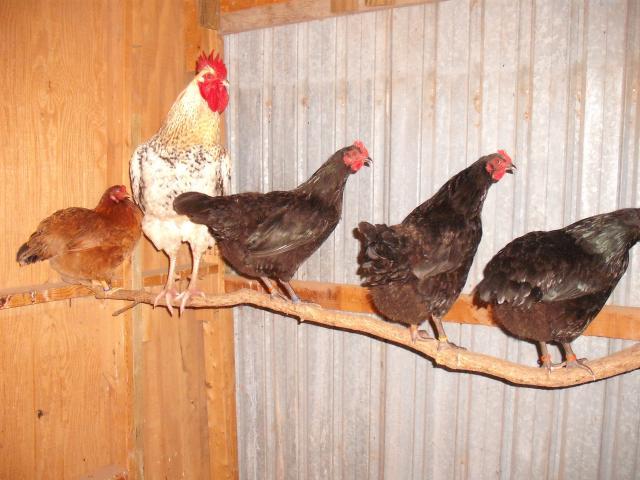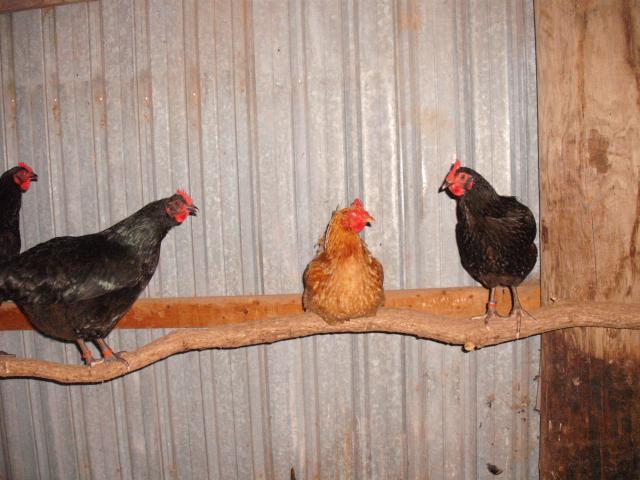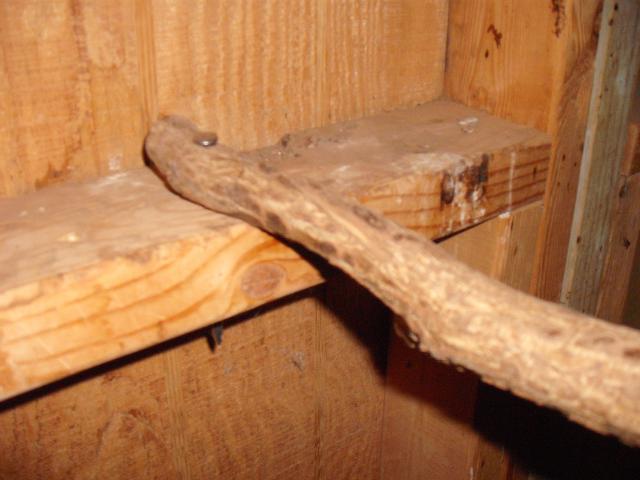I just looked at my wrist and it's on the thinner side and it is more of an oval shape than flat. So I vote for a 2" round sapling.
Navigation
Install the app
How to install the app on iOS
Follow along with the video below to see how to install our site as a web app on your home screen.
Note: This feature may not be available in some browsers.
More options
You are using an out of date browser. It may not display this or other websites correctly.
You should upgrade or use an alternative browser.
You should upgrade or use an alternative browser.
Roost shapes
- Thread starter Sonic Pug
- Start date
I switched out all my deminsional lumber roost for trees. The favorite roost right now is outside and about 3" thick. It goes across the run. Out of 9 chickens, only 2 were inside last night.
There is a myth floating around on this forum that chickens' feet are not like all other birds' feet and cannot grasp around a tree limb or something round like that but instead their toes stay perfectly straight when they perch or roost. It's usually best to not believe everything you read on the internet.
There is a thought that if you live in a truly cold climate, chickens roosting on the flat side of a 2x4 will settle down on their feet and keep them warm. I use tree limbs of varying sizes and have never had a problem with frost-bitten feet. It seldom gets much below zero Fahrenheit here so I don't have experience with truly cold temperatures, but the flat board theory has a certain ring of logic to it.
Some people have reported on here that changing the roosts have caused chickens to start roosting or such, so they believe that chickens care about roost shape. There may be something to that. I really don't know. I have tried putting boards up with my roosts to see what happens. My chickens pereferred the round tree limbs, but chickens are creatures of habit and maybe they just did not like the change. I've also tried changing the tree limbs around to see what happens, since my tree limbs are not the same diameter all the way across and they are not straight, so the high spots change. Some of them did change their roosting position when I did that, but I think it had more to do with the new high spots than the diameter. The position of the window probably had something to do with which chickens switched and which did not.
I really don't think it matters that much what shape they are. Different things work for different ones of us. I'll repeat a few things that others have said. Use wood. Plastic and metal are too slick and/or cold in the winter. If you use flat boards, round off the corners to make it easier on their feet and to remove splinters. I'd suggest sanding them. If you use wide boards watch to see if you need to scrape the poop off of them. Chickens should not be roosting in a layer of poop.
Here is what mine look like when I am down to one tree limb with my basic laying/breeding flock in their favorite roosting spots this past spring.


There is a thought that if you live in a truly cold climate, chickens roosting on the flat side of a 2x4 will settle down on their feet and keep them warm. I use tree limbs of varying sizes and have never had a problem with frost-bitten feet. It seldom gets much below zero Fahrenheit here so I don't have experience with truly cold temperatures, but the flat board theory has a certain ring of logic to it.
Some people have reported on here that changing the roosts have caused chickens to start roosting or such, so they believe that chickens care about roost shape. There may be something to that. I really don't know. I have tried putting boards up with my roosts to see what happens. My chickens pereferred the round tree limbs, but chickens are creatures of habit and maybe they just did not like the change. I've also tried changing the tree limbs around to see what happens, since my tree limbs are not the same diameter all the way across and they are not straight, so the high spots change. Some of them did change their roosting position when I did that, but I think it had more to do with the new high spots than the diameter. The position of the window probably had something to do with which chickens switched and which did not.
I really don't think it matters that much what shape they are. Different things work for different ones of us. I'll repeat a few things that others have said. Use wood. Plastic and metal are too slick and/or cold in the winter. If you use flat boards, round off the corners to make it easier on their feet and to remove splinters. I'd suggest sanding them. If you use wide boards watch to see if you need to scrape the poop off of them. Chickens should not be roosting in a layer of poop.
Here is what mine look like when I am down to one tree limb with my basic laying/breeding flock in their favorite roosting spots this past spring.


I have lived in Indiana or Missouri most of my life with chickens that roost with minimal protection from wind even when temperatures less than -10 F. Not issues I can attribute to round roost poles / sticks. My roost are dowels or limbs as shown by ridgerunner. Only problem I have with round roost is they are more difficult to keep from rolling.
NOTE: A couple of my breeds, American dominique and California greys (especially latter), appear to have much weaker feet for grasping my arm than similar sized American games and especially red jungle fowl. Others need to make similar comparison to refute or verify.
NOTE: A couple of my breeds, American dominique and California greys (especially latter), appear to have much weaker feet for grasping my arm than similar sized American games and especially red jungle fowl. Others need to make similar comparison to refute or verify.

I don't have issues with rolling. Each limb is cut to angle against the wall, set in top of a 2x4 block and I then used 3 inch screws to secure them to the wall. The screws are on the sides and underneath driven deep into the wood to protect feet and toes from catching them, plus they are so sturdy I can use them as a ladder to work on the ceiling of my coop.
I've always had round roosts, either tree limbs or closet bars. Really I don't think they care so long as they can get up off the ground.
Quote:
Mine don't roll. I drill a hole through the roost and the support and drop a large nail through to keep it from rolling. These are real easy to take out if I want to remove the roosts for cleaning.

Mine don't roll. I drill a hole through the roost and the support and drop a large nail through to keep it from rolling. These are real easy to take out if I want to remove the roosts for cleaning.

Mine get 2X4's because of the cold weather. If a toe is out from under their feathered breast, like curled over the edge of a board or dowl, it will get frost bitten and fall off. So, for the sake of toes, I keep the 2X4's, they roost on the wide flat side and I haven't had a single complaint from them.
Well, other than the occasional "She's in MY spot!!!"

Well, other than the occasional "She's in MY spot!!!"

If you take the time to walk under your roosts when the birds are there, you will find that you never really see a toe out from under feathers on a round roost. Birds won't just sit and let their feet freeze but will stand and pull a foot up and into their feathers. If you have a chicken that lets its toes freeze off this is one dumb bird and needs eliminated from your breeding plan!

If you bend a bird's leg, you will see the toes contract into a grasping motion. This is a built in feature and helps birds stay on a limb while sleeping...sort of locks in the feet/grasp. This is a natural thing.
As long as your round roosts are sized to fit the size of your chicken, there shouldn't be a problem with comfort. I find that tree limbs the size of my wrist are just perfect and smaller ends of the branch are suitable for younger birds. I wouldn't expect my gals to roost on a flat surface...that would be just like sleeping on the floor and makes building roosts a moot point.

If you bend a bird's leg, you will see the toes contract into a grasping motion. This is a built in feature and helps birds stay on a limb while sleeping...sort of locks in the feet/grasp. This is a natural thing.
As long as your round roosts are sized to fit the size of your chicken, there shouldn't be a problem with comfort. I find that tree limbs the size of my wrist are just perfect and smaller ends of the branch are suitable for younger birds. I wouldn't expect my gals to roost on a flat surface...that would be just like sleeping on the floor and makes building roosts a moot point.
- Thread starter
- #20
Thanks everyone for the great responses. I think I am going to go with natural tree branches from an olive tree we had that fell during a storm. I live in an area of California that never really freezes or snows so I think the birds will do well on the round branches. Thanks
New posts New threads Active threads
-
Latest threads
-
-
-
-
Winterizing coop
- Started by Chickensall4me
- Replies: 2
-
-
Threads with more replies in the last 15 days
-
-
-
I culled my first cockerel, now what?
- Started by redinator
- Replies: 86
-
*Answer These Questions The Best You Can Please *
- Started by N3mesis_IceWing_NightWing
- Replies: 58
-
-
×

